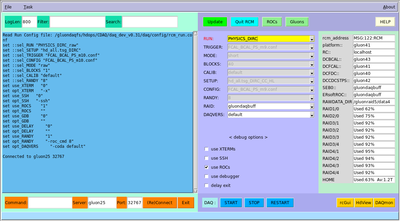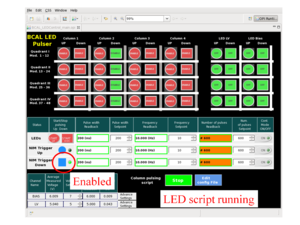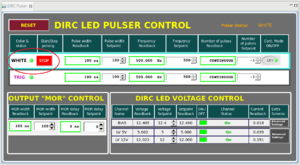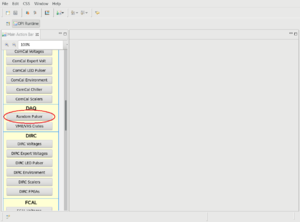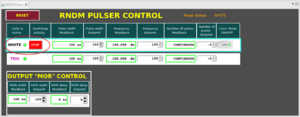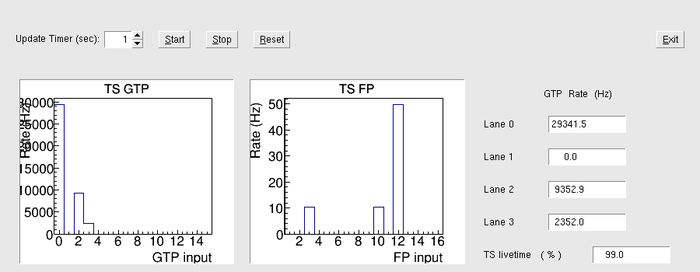Difference between revisions of "Level-1 Trigger Shift"
(→2. TS Front Pannel Triggers) |
|||
| (46 intermediate revisions by the same user not shown) | |||
| Line 4: | Line 4: | ||
selected on the RCM Run Config GUI when you start DAQ using '''rcm.sh''' (see descriptions at | selected on the RCM Run Config GUI when you start DAQ using '''rcm.sh''' (see descriptions at | ||
the DAQ page). Make sure that the following config parameters are set: | the DAQ page). Make sure that the following config parameters are set: | ||
| + | |||
| Line 9: | Line 10: | ||
|- | |- | ||
| '''RUN:''' | | '''RUN:''' | ||
| − | | | + | | PHYSICS_DIRC |
|- | |- | ||
| − | | ''' | + | | '''RAID:''' |
| − | | | + | | gluondaqbuff |
|- | |- | ||
| − | | ''' | + | | '''DAQVERS:''' |
| − | | | + | | default |
| − | + | ||
| − | + | ||
| − | + | ||
|} | |} | ||
| − | [[File: | + | [[File:rcm_ref.png|Main DAQ settings|400px|center|caption]] |
| − | + | ||
| − | + | ||
| − | + | ||
| + | === Cosmic runs === | ||
| + | Configuration files for cosmic runs are '''BCAL_cosmic_raw.conf''' (raw waveforms) or '''BCAL_cosmic_prod.conf''' (production mode) | ||
| Line 59: | Line 56: | ||
==== 2. TS Front Pannel Triggers ==== | ==== 2. TS Front Pannel Triggers ==== | ||
| − | Several ancillary triggers run in parallel to | + | Several ancillary LED triggers and the random trigger run in parallel to |
| − | through the TS front | + | physics triggers. These triggers are distributed through the TS front panel (FP), and are used to monitor detector performance. Each FP trigger type has a specific trigger bit assigned. Trigger bits and corresponding rates are listed in the table below: |
| − | listed below: | + | |
| − | + | ||
| − | + | ||
| − | + | ||
| − | + | ||
| − | + | ||
| − | + | ||
| − | + | ||
| − | + | ||
| − | + | ||
| − | + | ||
| − | + | ||
| − | + | ||
| Line 86: | Line 70: | ||
! FCAL LED | ! FCAL LED | ||
! 3 | ! 3 | ||
| − | ! | + | ! 10 Hz |
|- | |- | ||
! BCAL LED | ! BCAL LED | ||
! 9, 10 (single or both bits can be seen, depending on the bcal LED script) | ! 9, 10 (single or both bits can be seen, depending on the bcal LED script) | ||
| − | ! | + | ! 10 Hz |
| + | |- | ||
| + | |- | ||
| + | ! DIRC LED | ||
| + | ! 15 | ||
| + | ! 500 Hz | ||
|- | |- | ||
! Random | ! Random | ||
! 12 | ! 12 | ||
| − | ! | + | ! 100 Hz |
|} | |} | ||
| + | |||
| + | The LED and random triggers can be enabled (disabled) using CSS. If you | ||
| + | do not see corresponding trigger bits in the online monitoring plots | ||
| + | (RootSpy) or the trigger monitor "trig_client", make sure that the | ||
| + | corresponding pulsers are enabled using CSS screens for the following | ||
| + | subdetectors: | ||
| + | * '''FCAL and BCAL LED triggers (bits 3, 9, and 10)''' | ||
| − | + | In GlueX production runs, the FCAL and BCAL LEDS are | |
| − | + | controlled by scripts, which alternate several LED configurations | |
| − | + | (different LED colors and LED voltages for FCAL, upstream and | |
| − | + | downstream LEDs for various BCAL columns etc.). In the online | |
| + | monitoring plot one expect to see bits 3 and one (or both) bits | ||
| + | 9 and 10. Scrips for both the FCAL and BCAL LED pulsers can be | ||
| + | enabled using the CSS "BCALL LED pulser" screen | ||
| + | as shown below. | ||
| − | <gallery widths=300px heights=300px perrow=7 caption="CSS screens for | + | <gallery widths=300px heights=300px perrow=7 caption="CSS screens for the BCAL LED pulser. Make sure that scripts are running (see green button below)"> |
| − | + | ||
File:bcal_css.png | File:bcal_css.png | ||
| − | |||
</gallery> | </gallery> | ||
| + | |||
| + | |||
| + | * '''DIRC LED Trigger (bit 15)''' | ||
| + | |||
| + | LED trigger for DIRC can be enabled using a "DIRC LED Pulser" CSS screen as shown below: | ||
| + | |||
| + | |||
| + | <gallery widths=300px heights=300px perrow=7 caption="CSS screens for DIRC LED pulsers"> | ||
| + | File:dirc_led.png | ||
| + | </gallery> | ||
| + | |||
| + | * '''Random Trigger (bit 12)''' | ||
| + | |||
| + | Random trigger can be enabled from the "Random Pulser" screen in the DAQ section of the CSS | ||
| + | |||
| + | |||
| + | <gallery widths=300px heights=300px perrow=7 caption="CSS screens used to enable random trigger"> | ||
| + | File:random_daq.png | ||
| + | File:random_screen.png | ||
| + | </gallery> | ||
| + | |||
| + | If you do not see LED trigger bits for the FCAL/BCAL or DIRC, call to | ||
| + | subdetector experts on call. | ||
=== Trigger Monitor === | === Trigger Monitor === | ||
| Line 117: | Line 138: | ||
To run the program: | To run the program: | ||
| − | # Login to the | + | # Login to the gluon100 machine under hdops and execute '''trig_client'''. |
# If '''trig_client''' is already running, you will get the message on the xterm screen. | # If '''trig_client''' is already running, you will get the message on the xterm screen. | ||
:: To restart the client, kill the process and delete the logfile | :: To restart the client, kill the process and delete the logfile | ||
| Line 129: | Line 150: | ||
'''NOTE:''' '''Lane 0''' on this plot corresponds to the trigger '''BIT 1'''. | '''NOTE:''' '''Lane 0''' on this plot corresponds to the trigger '''BIT 1'''. | ||
| − | |||
| − | |||
| − | |||
| − | |||
| − | |||
=== Trigger Rates for Production Runs === | === Trigger Rates for Production Runs === | ||
| Line 144: | Line 160: | ||
Below are some reference plots of the physics trigger rate (BCAL & FCAL, which is used for production) for two types of radiators: '''JD70-100 crystal''' and | Below are some reference plots of the physics trigger rate (BCAL & FCAL, which is used for production) for two types of radiators: '''JD70-100 crystal''' and | ||
| − | ''' | + | '''4.5x10<sup>-4</sup> X<sub>0</sub>''' Aluminum. The PS trigger rate corresponds to the 75 mu thick Be converter and 5 mm collimator. Typical rates for production |
at small luminosity are: | at small luminosity are: | ||
| + | |||
| + | |||
| + | {|| class="wikitable" border="1" cellpadding="5" cellspacing="0" align="center" | ||
| + | |- | ||
| + | ! Radiator | ||
| + | ! Beam Current (nA) | ||
| + | ! colspan="3" style="text-align: center;" | Trigger Rate (kHz) | ||
| + | |- | ||
| + | ! colspan="2" style="text-align: center;" | | ||
| + | ! BIT 1: (FCAL & BCAL) | ||
| + | ! BIT 4: PS | ||
| + | ! Total | ||
| + | |- | ||
| + | | '''JD70-100''' | ||
| + | | style="text-align: center;" | 150 | ||
| + | | style="text-align: center;" | 35 - 40 | ||
| + | | style="text-align: center;" | 3.3 - 3.6 | ||
| + | | style="text-align: center;" | 40 - 45 | ||
| + | |- | ||
| + | | '''4.5x10<sup>-4</sup> X<sub>0</sub> Aluminum ''' | ||
| + | | style="text-align: center;" | 180 | ||
| + | | style="text-align: center;" | 32 - 38 | ||
| + | | style="text-align: center;" | 2. - 2.5 | ||
| + | | style="text-align: center;" | 38 - 42 | ||
| + | |} | ||
| + | |||
| + | <!-- | ||
{|| class="wikitable" border="1" cellpadding="5" cellspacing="0" align="center" | {|| class="wikitable" border="1" cellpadding="5" cellspacing="0" align="center" | ||
| Line 172: | Line 215: | ||
|} | |} | ||
| + | --> | ||
| Line 178: | Line 222: | ||
| + | [[File:rate_diamond_2018.png | JD70-100 crystal radiator |500px|center| Fig. 1]] | ||
| + | <!-- [[File:L1_rate_crystal.png | JD70-100 crystal radiator |500px|center| Fig. 1]] --> | ||
| − | |||
| + | <!-- Rate of the main production trigger (FCAL & BCAL) as a function of the PS rate | ||
| + | for the '''3x10<sup>-4</sup> X<sub>0</sub> Aluminum ''' radiator. | ||
| + | |||
| + | |||
| + | [[File:L1_rate_amorp.png | Amorphous radiator |500px|center|caption]] --> | ||
Rate of the main production trigger (FCAL & BCAL) as a function of the PS rate | Rate of the main production trigger (FCAL & BCAL) as a function of the PS rate | ||
| − | for the ''' | + | for the '''4.5x10<sup>-4</sup> X<sub>0</sub> Aluminum ''' radiator. |
| − | [[File: | + | * '''DAQ dead time''' |
| + | The typical DAQ dead time for main production runs is 95 - 98 %. If the dead time appears to be systematically smaller | ||
| + | (on the level of 80 %) experts should be called. | ||
| + | |||
| + | |||
| + | [[File:Rate_amorh_45_2018.png | Amorphous radiator |500px|center|caption]] | ||
<span style="color:#FF0000"> '''Rate Troubleshooting''' </span> | <span style="color:#FF0000"> '''Rate Troubleshooting''' </span> | ||
| + | |||
| + | |||
| − | ''' If the trigger rate is significantly different from that listed in the table.''' | + | ''' If the trigger rate is significantly different from that listed in the table (by more than 20 %).''' |
# Check the PS rate. If it appears to be smaller than expected, the beam may not be tuned properly resulting in a small collimation efficiency. Check beam positions at the active collimator and BPMs (see numbers written on the white board), call MCC. | # Check the PS rate. If it appears to be smaller than expected, the beam may not be tuned properly resulting in a small collimation efficiency. Check beam positions at the active collimator and BPMs (see numbers written on the white board), call MCC. | ||
| Line 207: | Line 264: | ||
! width=200px | Name !! width=100px | Extension !! Date of qualification | ! width=200px | Name !! width=100px | Extension !! Date of qualification | ||
|- | |- | ||
| − | | Alexander Somov || align=center | | + | | Alexander Somov || align=center | 383-3446 JLab: 5553 || align=center | June 20, 2015 |
|} | |} | ||
Latest revision as of 19:45, 20 October 2021
Contents
Configuration for Production Runs
Production data is taken with the following configuration. The configuration has to be selected on the RCM Run Config GUI when you start DAQ using rcm.sh (see descriptions at the DAQ page). Make sure that the following config parameters are set:
| RUN: | PHYSICS_DIRC |
| RAID: | gluondaqbuff |
| DAQVERS: | default |
Cosmic runs
Configuration files for cosmic runs are BCAL_cosmic_raw.conf (raw waveforms) or BCAL_cosmic_prod.conf (production mode)
Trigger Types
1. GTP Triggers
Currently, the following main Global Trigger Processor (GTP) triggers are used for data production:
| Trigger Type | Trigger Bit (starting from 1) |
|---|---|
| FCAL + 0.5 BCAL > 0.5 GeV | 1 |
| BCAL > 1.1 GeV | 3 |
| PS | 4 |
Trigger bits used in spring 2016 are can be found here.
2. TS Front Pannel Triggers
Several ancillary LED triggers and the random trigger run in parallel to physics triggers. These triggers are distributed through the TS front panel (FP), and are used to monitor detector performance. Each FP trigger type has a specific trigger bit assigned. Trigger bits and corresponding rates are listed in the table below:
Assignment of the TS FP trigger bits and typical trigger rates are shown in the table:
| Trigger Type | Trigger Bit (starting from 1) | Typical rate |
|---|---|---|
| FCAL LED | 3 | 10 Hz |
| BCAL LED | 9, 10 (single or both bits can be seen, depending on the bcal LED script) | 10 Hz |
| DIRC LED | 15 | 500 Hz |
| Random | 12 | 100 Hz |
The LED and random triggers can be enabled (disabled) using CSS. If you do not see corresponding trigger bits in the online monitoring plots (RootSpy) or the trigger monitor "trig_client", make sure that the corresponding pulsers are enabled using CSS screens for the following subdetectors:
- FCAL and BCAL LED triggers (bits 3, 9, and 10)
In GlueX production runs, the FCAL and BCAL LEDS are controlled by scripts, which alternate several LED configurations (different LED colors and LED voltages for FCAL, upstream and downstream LEDs for various BCAL columns etc.). In the online monitoring plot one expect to see bits 3 and one (or both) bits 9 and 10. Scrips for both the FCAL and BCAL LED pulsers can be enabled using the CSS "BCALL LED pulser" screen as shown below.
- CSS screens for the BCAL LED pulser. Make sure that scripts are running (see green button below)
- DIRC LED Trigger (bit 15)
LED trigger for DIRC can be enabled using a "DIRC LED Pulser" CSS screen as shown below:
- CSS screens for DIRC LED pulsers
- Random Trigger (bit 12)
Random trigger can be enabled from the "Random Pulser" screen in the DAQ section of the CSS
- CSS screens used to enable random trigger
If you do not see LED trigger bits for the FCAL/BCAL or DIRC, call to subdetector experts on call.
Trigger Monitor
Trigger rates produced by the detector (generated by the GTP) and also distributed from the TS front pannel can be monitored using trig_client program. To run the program:
- Login to the gluon100 machine under hdops and execute trig_client.
- If trig_client is already running, you will get the message on the xterm screen.
- To restart the client, kill the process and delete the logfile
- /home/hdops/CDAQ/config/hd_server/trig_client.log
An example of the trigger monitor screen, is shown below
NOTE: Lane 0 on this plot corresponds to the trigger BIT 1.
Trigger Rates for Production Runs
Trigger rate depends on the luminosity (flux of collimated photons), which can vary for different electron beam currents, radiator types, and tagging efficiency. The photon flux can be measured using the pair spectrometer. Therefore, it is practical to relate the rate of the main physics trigger to the PS rate.
Below are some reference plots of the physics trigger rate (BCAL & FCAL, which is used for production) for two types of radiators: JD70-100 crystal and
4.5x10-4 X0 Aluminum. The PS trigger rate corresponds to the 75 mu thick Be converter and 5 mm collimator. Typical rates for production
at small luminosity are:
| Radiator | Beam Current (nA) | Trigger Rate (kHz) | ||
|---|---|---|---|---|
| BIT 1: (FCAL & BCAL) | BIT 4: PS | Total | ||
| JD70-100 | 150 | 35 - 40 | 3.3 - 3.6 | 40 - 45 |
| 4.5x10-4 X0 Aluminum | 180 | 32 - 38 | 2. - 2.5 | 38 - 42 |
Rate of the main production trigger (FCAL & BCAL) as a function of the PS rate for runs with JD70-100 radiator
Rate of the main production trigger (FCAL & BCAL) as a function of the PS rate
for the 4.5x10-4 X0 Aluminum radiator.
- DAQ dead time
The typical DAQ dead time for main production runs is 95 - 98 %. If the dead time appears to be systematically smaller (on the level of 80 %) experts should be called.
Rate Troubleshooting
If the trigger rate is significantly different from that listed in the table (by more than 20 %).
- Check the PS rate. If it appears to be smaller than expected, the beam may not be tuned properly resulting in a small collimation efficiency. Check beam positions at the active collimator and BPMs (see numbers written on the white board), call MCC.
- Check DAQ.
| Name | Extension | Date of qualification |
|---|---|---|
| Alexander Somov | 383-3446 JLab: 5553 | June 20, 2015 |
